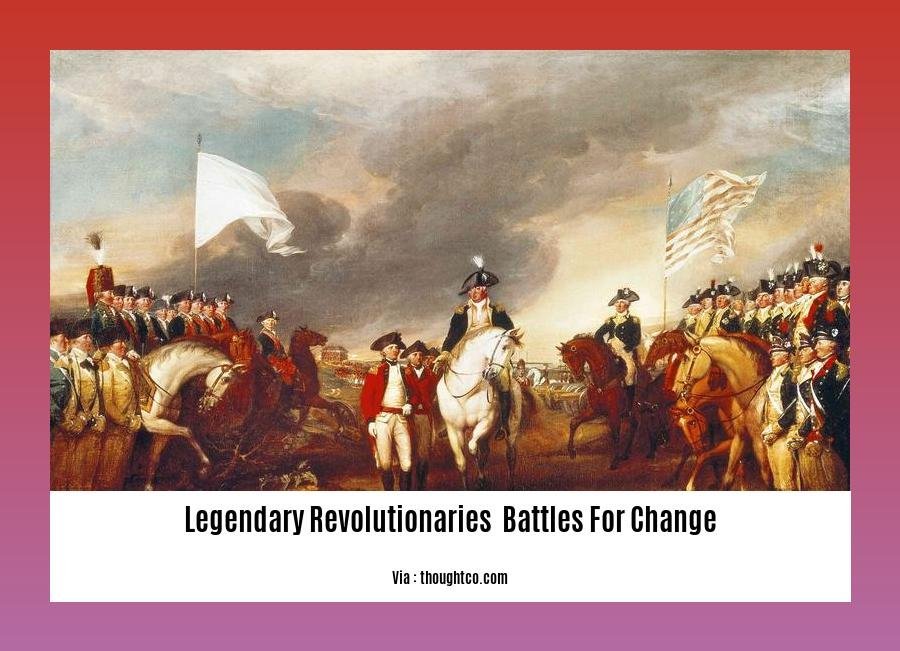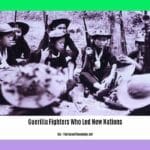Prepare for an immersive journey into [The Legendary Revolutionaries’ Battles for Change: A Historical Exploration]. Delve into the extraordinary stories of individuals who dared to challenge the established order, waging heroic battles that reshaped the course of history. Through captivating narratives, expert insights, and compelling accounts, we’ll unravel their motivations, sacrifices, and the profound impact of their struggles. Join us as we pay tribute to these unsung heroes and explore the transformative power of their revolutionary battles!

Key Takeaways:
- Che Guevara was a Marxist revolutionary, physician, and guerrilla leader who played a crucial role in the Cuban Revolution.
- His iconic image has become a symbol of rebellion and social justice.
- Guevara’s writings on politics and revolution, such as “Guerrilla Warfare” and “The Bolivian Diary,” continue to inspire revolutionaries worldwide.
- He believed strongly in Marxist principles, anti-imperialism, and social justice.
Legendary Revolutionaries’ Battles for Change
Che Guevara’s Impactful Battles for a Socialist Cuba
Che Guevara, a renowned revolutionary icon, played a pivotal role in the legendary revolutionaries’ battles for change. A Marxist revolutionary, Guevara fought relentlessly for social justice, particularly in Cuba. His commitment to anti-imperialism and his belief in the power of the masses fueled his revolutionary fervor.
Guevara’s involvement in the Cuban Revolution began in 1956 when he joined Fidel Castro’s guerrilla movement. His strategic thinking and military prowess proved invaluable during the guerrilla warfare campaign against the Batista dictatorship. Guevara’s leadership and charisma inspired many Cubans to join the revolutionary cause.
After the revolution’s success in 1959, Guevara held key positions in the new Cuban government, including Minister of Industry and President of the National Bank. He championed socialist policies aimed at improving education, healthcare, and social welfare for the Cuban people.
Guevara’s unwavering belief in revolution extended beyond Cuba. He traveled to other countries, supporting revolutionary movements and advocating for the rights of the oppressed. His writings, such as “Guerrilla Warfare” and “The Motorcycle Diaries,” continue to inspire revolutionaries worldwide.
In conclusion, Che Guevara’s legendary revolutionaries’ battles for change exemplified his unwavering commitment to social justice and his belief in the power of revolution. His legacy as a revolutionary icon continues to inspire and motivate those who fight for a more just and equitable world.
For a deep dive into the lives of those who fought for change, explore famous revolutionaries and their struggles. Delve into the challenges faced by renowned revolutionary fighters, and witness the transformative iconic revolutionaries and their storied movements.
Simón Bolívar and the Latin American Wars of Independence
From the depths of the 19th century, a revolutionary force arose, led by the towering figure of Simón Bolívar, the Liberator. His name echoed across the battlefields of South America, igniting the flames of independence and carving a new destiny for a continent yearning for freedom.
Bolívar’s quest began in the vibrant cities and vast landscapes of South America, where the oppressive grip of Spanish colonialism cast a long shadow. Inspired by Enlightenment ideals and the thirst for self-determination, Bolívar rallied armies of rebels and embarked on a daring campaign that would reshape the political map of the region.
Key Tactics and Strategies:
- Guerrilla Warfare: Bolívar’s armies excelled in guerrilla tactics, using the dense jungle terrain to their advantage. They launched surprise attacks, harassed Spanish forces, and cut off their supply lines.
- Revolutionary Diplomacy: Bolívar was a skilled diplomat, forging alliances with key figures and securing international support for his cause. He negotiated with foreign powers, gaining recognition for the independence of South American nations.
As Bolívar’s armies marched from victory to victory, their triumphs inspired a sense of unity and hope among the oppressed peoples of South America. Countries such as Bolivia, Panama, Peru, Colombia, Ecuador, and Venezuela declared independence and embraced the promise of self-governance.
Key Takeaways:
- Legacy of Leadership: Bolívar’s unwavering determination and strategic brilliance laid the foundation for the independence of several South American nations.
- Guerrilla Warfare as a Catalyst: The use of guerrilla tactics by Bolívar’s armies proved highly effective in countering the superior military strength of the Spanish.
- International Diplomacy as an Ally: Bolívar’s diplomatic efforts played a crucial role in gaining international recognition for the independence of South American nations.
Citation:
Giuseppe Garibaldi and the Italian Unification
Imagine a world divided, fragmented into small, often-warring states, each with its unique identity and language. Now, picture a man who dared to dream of uniting these scattered pieces into a single nation. That man was Giuseppe Garibaldi, a legendary revolutionary whose unwavering determination and military prowess played a pivotal role in the unification of Italy.
Garibaldi’s journey began amidst the political turmoil of the 19th century. Italy, a land steeped in history and culture, was a patchwork of independent states, often dominated by foreign powers. Inspired by ideals of nationalism and liberty, Garibaldi joined the movement for Italian unification, the Risorgimento.
Leading a guerrilla army known as the Red Shirts, Garibaldi embarked on a series of daring campaigns. With his charismatic leadership and tactical brilliance, he rallied Italians from all walks of life to fight for their freedom. Battles were fought, cities were liberated, and the dream of a unified Italy gained momentum.
Garibaldi’s victories inspired patriotic fervor and ignited a belief in the possibility of a united nation. His unwavering commitment and personal sacrifices became a symbol of the struggle for Italian independence. Through his military exploits and political alliances, Garibaldi played a crucial role in the overthrow of foreign rule and the establishment of a unified Italy in 1861.
Key Takeaways:
- Giuseppe Garibaldi was a key figure in the Italian Unification movement.
- He led the Red Shirts, a guerrilla army known for its courage and success.
- Garibaldi’s military campaigns and leadership inspired patriotic fervor and contributed to the overthrow of foreign rule.
- The unification of Italy under Garibaldi’s leadership was a significant milestone in the history of the nation.
Relevant URL Source:
- Giuseppe Garibaldi – Bio, Facts, & Italian Unification
Nelson Mandela and the Anti-Apartheid Movement
In the face of apartheid’s oppressive regime, a beacon of resistance emerged: Nelson Mandela. Imprisoned for 27 years for his unwavering activism, Mandela became a symbol of hope for a South Africa free from racial segregation.
Born in 1918, Mandela joined the African National Congress (ANC) in 1944, dedicating his life to fighting apartheid. His nonviolent methods, inspired by Mahatma Gandhi, aimed to dismantle the racist system peacefully.
Despite brutal repression, Mandela’s resolve remained unshaken. After being imprisoned in 1964, he became an international icon, inspiring global condemnation of apartheid.
In 1990, with the world’s pressure mounting, Mandela was released from prison. He negotiated with the apartheid government, leading to the country’s first multiracial elections in 1994. Mandela became South Africa’s first black president, serving from 1994 to 1999.
During his presidency, Mandela established the Truth and Reconciliation Commission to document the atrocities committed under apartheid. He also implemented policies aimed at bridging the racial divide, promoting reconciliation, and fostering economic development.
However, Mandela’s presidency was not without challenges. Some criticized his handling of violence, particularly the rise of crime during his tenure.
Despite these criticisms, Nelson Mandela’s legacy as a revolutionary leader remains unyielding. His unwavering commitment to fighting apartheid, his ability to reconcile a divided nation, and his enduring spirit continue to inspire generations.
Key Takeaways:
- Nelson Mandela, a symbol of resistance, spent 27 years in prison for fighting apartheid.
- He became South Africa’s first black president, leading the country towards reconciliation and democracy.
- The Truth and Reconciliation Commission, established under Mandela’s leadership, documented human rights abuses during apartheid.
- Despite criticism, Mandela’s legacy as a revolutionary and unifier endures.
Relevant URL Source:
- Nelson Mandela’s Fight Against Racism In South Africa

FAQ
Q1: Who were some of the most famous revolutionaries in history?
A1: Che Guevara, Simon Bolivar, Giuseppe Garibaldi, and Nelson Mandela are just a few of the many legendary revolutionaries who have fought for change.
Q2: What were some of the key battles that these revolutionaries fought?
A2: Guevara played a key role in the Cuban Revolution, Bolivar led the independence movements in South America, Garibaldi fought for the unification of Italy, and Mandela fought against apartheid in South Africa.
Q3: What were the motivations of these revolutionaries?
A3: The motivations of revolutionaries vary, but they often include a desire for social justice, freedom, and independence.
Q4: What were the outcomes of these revolutions?
A4: The outcomes of revolutions can be complex and varied, but they often lead to significant changes in society and government.
Q5: What can we learn from the stories of these revolutionaries?
A5: The stories of revolutionaries can teach us about the power of courage, determination, and sacrifice. They can also inspire us to fight for our own beliefs and values.
- Unlock Water’s Symbolism: A Cross-Cultural Exploration - April 20, 2025
- Identify Black and White Snakes: Venomous or Harmless? - April 20, 2025
- Unlocking Potential: Origins High School’s NYC Story - April 20, 2025















